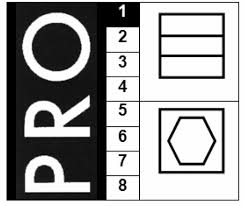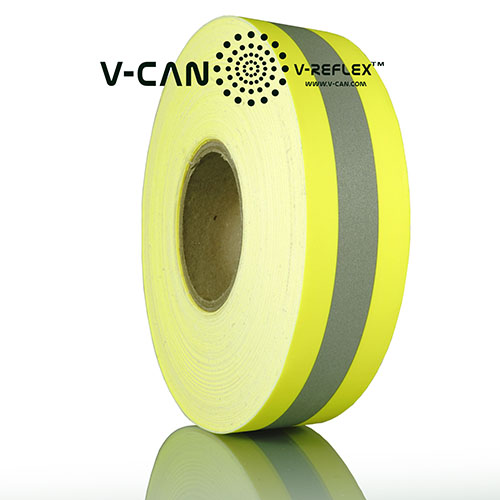
V-REFLEXTM Reflective Material - High Visible Flame Resistant and Industrial Wash Retro-Reflective Tape/Trim (Above Product Code) is designed for use on flame resistant, and arc flash resistant safety garments.
V-REFLEXTM Reflective Material - High Visible Reflective Tape/Trim is composed of wide angle, exposed retro-reflective (without metallized) lenses, with a high visible fluorescent lime-yellow or fluorescent orange layer, bonding to a durable inherent flame resistant textile fabric or fire treated cotton textile fabric.
By intregrating function of high visbility and high retro-reflectivity on the same surface, this series of FR reflective tape perform a very high visibility, conform to mutiple national standards for fire fighting garment.
When properly used, V-REFLEXTM Reflective Material - Flame Resistant and Industrial Wash Retro-Reflective Tape/Trim help enhance the visibility of the wearer in nighttime or low-light conditions when illuminated by a light source such as headlights, by returning the light back toward the original source and reaching the automobile driver's eye. The high visible part on retro-reflective tape give off fluorescent looking in the daytime to help wearers standing out of the scenes, and be seen.
V-REFLEXTM Reflective Material - Retro-Reflective Fabric/Tape meets or exceeds the following specifications as noted. All RA values are over 100 cd/lux/m2 measured at +5.0° entrance angle and 0.2° observation angle after tests are carried out according to following test method
Retro-reflectivity (initial): ANSI/ISEA 107-2010 level 2 , EN ISO 20471
OEKO-TEX 100: Product Class II
Abrasion: 5000 cycles (EN 530 Method 2) | RA > 100
Flexing: 7500 cycles (ISO 7854 Method A) | RA > 100
Cold Fold: -20° (ISO 4675) | RA > 100
Temperature Variation: 50 hours @ 50 °C and 20 hours @ -30 °C | RA > 100
Industrial Wash: 30 cycles @ 75°C (ISO 15797) | RA > 100
Dry-Cleaning: 30 cycles (ISO 3175) | RA > 100
Wet Reflectivity: ANSI/ISEA 107-2010, EN ISO 20471 | RA > 100
Flame Resistant and Fire Retardant:
- EN 469:2005; EN ISO 14116:2008; EN ISO 11611:2015; EN ISO 11612:2015
- NFPA 1971:2013; NFPA 1977:2016; NFPA 2112:2012
V-REFLEXTM Reflective Material - Retro-Reflective Fabric/Tape exceeds the minimum reflectivity requirements of EN ISO 20471, table 5 - minimum coefficient of retro-reflection in cd/lux/m2 for combined performance material.
Coefficient of Retro-reflection * (R' or RA ) cd/lux/m2
|
Observation Angle |
Entrance Angle (?1, ?2=0) |
|||
|
5° |
20° |
30° |
40° |
|
|
0,20°(12') |
330 |
290 |
180 |
65 |
|
0,33°(20') |
250 |
200 |
170 |
60 |
|
1,00°(1°) |
25 |
15 |
12 |
10 |
|
1,50°(1°30') |
10 |
7 |
5 |
4 |
Measured on new product at +5.0° entrance and 0.2° observation angles, V-REFLEXTM Reflective Material - Retro-Reflective Fabric/Tape typically has retro reflective performance as below table.
|
Initial Average RA |
Minimum RA |
|
500 |
300 |
Industrial Wash Guidelines
Industrial laundering means regularly washing large amounts of clothing in a relatively short amount of time, with large machines (>25 kg loads), aggressive detergent chemistry (pH10.5-12), and high wash temperatures (up to 85oC, 185oF).
Garment finishing (tumble dry or tunnel finish) can limit garment life and should be considered as part of the cleaning process. Using harsher cleaning condition than those recommended may significantly reduce product performance.
Washing
- Wash chemistry: Do not use detergents that contain free sodium hydroxide or potassium hydroxide.
- Maximum wash temperature: 75 °C (165 °F)
- Break/suds cycles: less than 15 minutes total
Drying
- Tunnel dry: Maximum inlet temperature 120 °C (250 °F)
For some items, maximum temperature could be as high as 155 °C
- Tumble dry: Maximum exhaust temperature 90 °C (195 °F)
Special Remarks for Industrial Wash (Industrial Laundry)
V-REFLEXTM Reflective Material - Industrial Wash Reflective Heat Transfer Film/Tape should be properly transferred to clothing, and bonding with clothing strongly. Improperly application handling may result in heat transfer film/tape falling away from clothing during daily use or cleaning procedure, especially in industrial wash cleaning operation.
We recommend that all customers, in accordance with good manufacturing practices, establish an ongoing quality system which includes maintaining lot/roll identification throughout the garment production process. Customer should also store input materials and final products in accordance with manufacturer ecommendations, as well as implement continuous testing throughout their production and on their finished garments that reflects their garment needs.
For lamination operations, customers should periodically check their equipment to ensure that the temperature set point matches the platen or roll temperature and that the temperature is uniform across the lamination area.
ISO 15797 Textiles - Industrial washing and finishing procedures for testing of workwear
V-REFLEXTM Reflective Material - Industrial Wash Reflective Heat Transfer Film/Tape were tested to ISO 15797, and classified into several quality levels according to their test results. The higher industrial wash cycles means longer time of durability when retro-reflective tape is sewn on or ironed on to safety garment.
Safety garments producers could choose the proper quality level of retro-reflective tape for sewing on their garments for specific purposes, such as, brand up-lifting, input cost cutting, quality level improving , extra value adding, ......
The industrial cleaning of protective clothing is very different from domestic or small commercial cleaning. The scale, the use of special washing and drying equipment and the use of special detergents all have a different effect on clothing and textiles.
The effects which occur as a result of the cleaning are dependent on the type of clothing, the fabric composition and the selected washing and drying process.
For different types of protective clothing, the following remarks are important but always follow the cleaning instructions of the manufacturer.
Clothing made from predominantly cotton
In many cases protective clothing are flame retardant products e.g. comply with EN ISO 11611 or 11612. These predominantly cotton clothing features a washable flame resistant finish.
In general, for the washing and drying of clothing made from predominantly cotton, the following applies:
- Do not "over dry" the clothing. This may lead to excessive shrinkage.
- The maximum number of washes is sometimes indicated in the care label and or the user instruction. If this is not specified then the clothing is tested to five times washing In practice the clothing will last longer but this must be sought from the supplier or manufacturer.
High visibility clothing
Protective clothing that complies with EN ISO 20471 has fluorescent fabric and retroreflective stiping. In general, for the washing and drying of these garments the following applies:
- Do not wash together with other (dark) coloured garments due to potential colour bleeding on the fluorescent colour.
- Never bleach or wash with white wash detergents (containing optical white).
- Irremovable soilling can reduce visibility.
- Excessive mechanical washing action can promote wear of the retroreflective striping.
Protective clothing against splashes of liquid chemicals
This clothing is usually characterized by that the protective properties are obtained by applying a fluorcarbon finish. These finishes are in some extent washable. Nevertheless, it is advisable to restore the finish after every washing cycle.
In general, for the washing and drying of this type of clothing the following applies:
- Use for washing an anionic detergent. (Non-ionic detergents have better washing action but are more difficult to remove in the rinsing process. Not removed detergent impede the water repellency action).
- After each washing cycle, apply a suitable fluorcarbon product to restore the repellency.
- Dry at sufficiently high temperature to activate the fluorcarbon finish but avoid excessive shrinkage.
- Check the effectiveness of the post-treatment at regular intervals.
Parkas and other multi-layer clothing
Characteristic for this type of garment is that they often contain a water vapour-permeable layer. However, this layer is also watertight and provided with tape on the seams.
This kind of clothing can be washed best in an open-end machine where special attention is needed to the dewatering (spin drying). This must be done in a way that this layer will not be damaged.
Multinorm clothing
Because multinorm clothing combines many of the above-mentioned types, to determine the most suitable industrial laundry process, all of the above mentioned recommendations will apply.
Labelling regarding the industrial laundry and drying of workwear and protective wear
ISO 30023 shows how industrial washable clothing can be labeled so that it is clear to the industrial laundry what washing and drying process is applicable.

The numbers 1 to 8 represent the number of the washing and drying procedures as specified in ISO 15797.
Furthermore, two symbols can be used which indicate whether the clothing can be dried in a tunnel finisher, or a drum dryer. If not applicable, this symbol is omitted from the label.
Store in a cool, dry area and use within 1 year of receipt.
Rolls should be stored in their original cartons, whilst partially used rolls should be returned to their carton or suspended horizontally from the core via a rod or pipe.
Cut sheets should be stored flat.

Product Featrue:
- Model Number:RT-FRIW308530-AHV1
- Initial RA: >500 CPL
- Micro glass bead, Non-oriental sensitive
- Approved to EN ISO 20471
- Approved to ANSI-ISEA 107
- Approved to EN 469
- Approved to NFPA 1971
- approved to EN 11611 11612
- Backing Fabric: Aramid
- Backing Fabric Color: Fluorescent Lime Yellow
- Centered Reflective Trim: Silver
- Industrial Wash: 30 Cycles@75°C ISO 15797
- Dry Clean: 30 Cycles per ISO 3175

Application
- Firefighting apparel
- Flame resistant occupational work wear
- Trousers
- Coats
- Coveralls
- Jackets
- Waistcoats and trousers
- Uniforms
